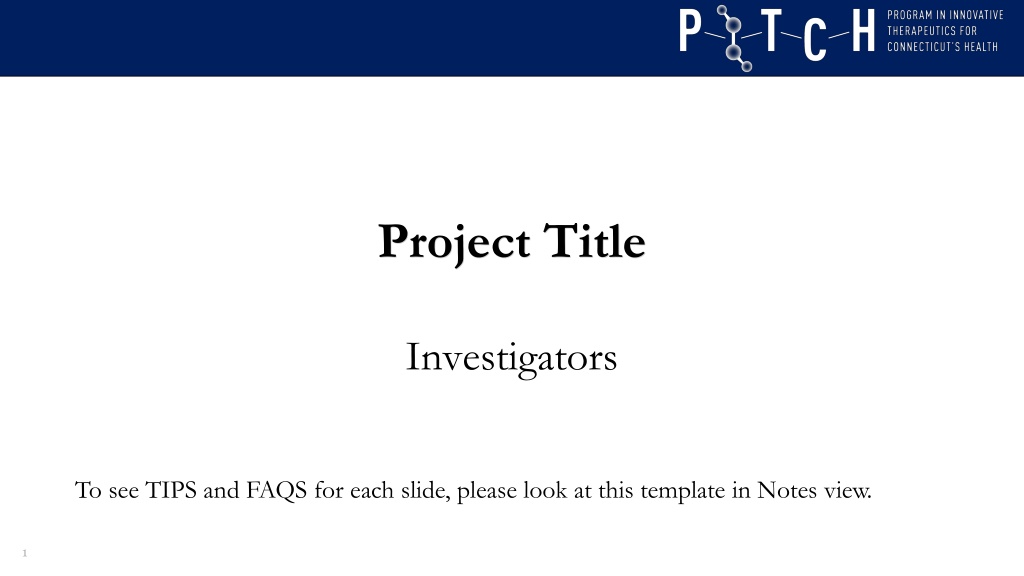Comprehensive Research Project Overview
This project overview template provides a structured approach for presenting key aspects of a research project, including the two-year goal statement, project team background, scientific background, research plan, assay feasibility assessment, med chem feasibility assessment, and clinical correlation assessment. Each section is accompanied by visual aids and prompts for detailed information. Utilize this template to effectively communicate the essential components of your research project.
Download Presentation

Please find below an Image/Link to download the presentation.
The content on the website is provided AS IS for your information and personal use only. It may not be sold, licensed, or shared on other websites without obtaining consent from the author. Download presentation by click this link. If you encounter any issues during the download, it is possible that the publisher has removed the file from their server.
E N D
Presentation Transcript
Project Title Investigators To see TIPS and FAQS for each slide, please look at this template in Notes view. 1
Two Year Goal Statement Your two year goal will frame the following assessment. 2
Project Team Brief background for team members and their roles on this project. Include relevant past experience, if any. 3
Scientific Background and Opportunity Briefly, introduce background science. What is the problem worth solving? What is your solution? Why is it novel? 4
Research Plan Describe additional research data needed but which is outside the scope and capability of the investigator s laboratory. 5
Assay Feasibility Assessment 1. Describe your target and biological pathway 2. Does biochemical assay exist? 3. Does a cell-based readout exist? 4. What additional assays (screening cascade) will you use to hone in on the best molecules? 5. What is your level of experience with the assays? 6. Are all critical reagents for the assays currently available? 6
Med. Chem. Feasibility Assessment 1. Target location(s): extracellular, intracellular, CNS, etc. and tissue type. 2. Can the protein be reliably expressed and purified? How? 3. Does crystal structure of target exist, resolution and RCSB code. If no, what are the closest homologs with crystal structure coordinates? 4. Predicted binding pocket affinity of target (YCMD determined); i.e., is the target druggable? 5. Are small molecule inhibitors known? 6. Synthetic accessibility (conducted after HTS analysis) 7
Clinical Correlation Assessment 1. Is the biology (i.e. pathway) well characterized? 2. Has modulation of the pathway been shown to correlate with changes in disease burden (e.g. phenotype of KO mice, relevant animal studies, GWAS) 3. Is there precedent for the MOA for similar disease targets? 4. Is there a reliable and predictive animal model that has a history in translating compounds to the clinic? 5. Does a clinically relevant biomarker exist? 6. Competition: Examine approved claims (efficacy and safety) of competitors. Examine the competitive environment for compounds currently in development. 8
Clinical Need/Potential Market 1-2 slides addressing: Number people affected by disease (target population) Current standard of care and market size (commercial potential) How efficient are the current approaches? (unmet clinical need) How does proposed treatment compare to standard of care? What is the specific value of your drug/approach to patients? What advantages does it offer over existing or competing approaches? Clinical trial feasibility. How can treatment efficiency be evaluated? If known biomarker or imaging results can predict treatment efficacy in Phase II clinical trials, include them here. 9
Targeted Product Attributes 1 slide describing the desired characteristics of the proposed therapeutic for the intended indication. Note this slide may be more relevant to projects entering PITCH at later stages, and can be left blank for projects entering at assay development/screening stage. 10
Intellectual Property Position 1 slide addressing Office of Cooperative Research/Technology Commercialization Services disclosure and patentability status 11
Supporting material Include key references as pdfs in your application. You may include up to 2 review articles and up to 2 research articles. The publications do not need to be from your lab. Highlight important points in the articles. 12

 undefined
undefined





















![Project Initiation Document for [Insert.Project.name] [Insert.Project.number]](/thumb/226757/project-initiation-document-for-insert-project-name-insert-project-number.jpg)

